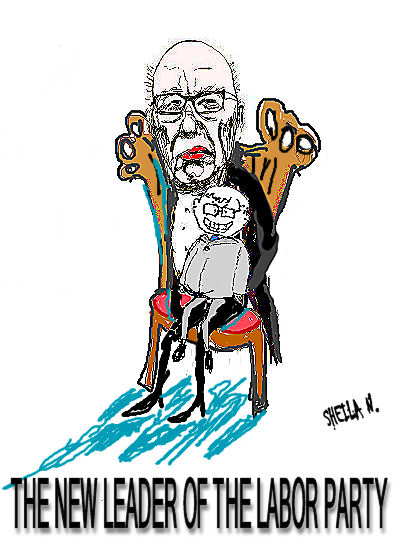Australia: Kelvin Thomson MP Wills Post Election statement on Labor's Future
 Mr Thomson received the strongest two-party vote of any Labor candidate in Australia in Labor's disaster 2013 election results. Inside a you-tube interview with Kelvin Thomson where he talks freely about what went wrong in recent government (among other things - seeking a 'messiah') and says that he will not recontest the front bench because he does not want to be muzzled (editorial word) from commenting on the massive issues of our times - species extinction, ecology, war, overpopulation, democracy ... Kelvin Thomson is known for his democratic consultation of his electorate and his reflection of their concerns. He is widely in touch with Australians everywhere and responsive to their issues of ecology, democracy, and population. Politicians everywhere should take note. Mr Thomson did not have to rely on pleasing Mr Murdoch, but Mr Murdoch still likes to report him because he makes too much sense and is too democratically influential to ignore.
Mr Thomson received the strongest two-party vote of any Labor candidate in Australia in Labor's disaster 2013 election results. Inside a you-tube interview with Kelvin Thomson where he talks freely about what went wrong in recent government (among other things - seeking a 'messiah') and says that he will not recontest the front bench because he does not want to be muzzled (editorial word) from commenting on the massive issues of our times - species extinction, ecology, war, overpopulation, democracy ... Kelvin Thomson is known for his democratic consultation of his electorate and his reflection of their concerns. He is widely in touch with Australians everywhere and responsive to their issues of ecology, democracy, and population. Politicians everywhere should take note. Mr Thomson did not have to rely on pleasing Mr Murdoch, but Mr Murdoch still likes to report him because he makes too much sense and is too democratically influential to ignore.Statement on Labor Frontbench, Labor's Future, Leadership, Policy & Wills Electorate
Thank you to the Wills Electorate
http://www.youtube.com/embed/5dqL5ErigKw?feature=player_detailpage
First I want to say a heartfelt thank you to the people of Wills, and to my campaign team, who have given me wonderful support throughout this election campaign, and indeed the months and years leading up to it. The Electoral Commission figures reported in this morning’s newspapers show that I have the strongest two-party preferred vote of any Labor candidate in Australia. These outcomes can change of course depending on final vote counting and preference distribution, but it is a great honour to have such a strong level of support, and I am determined to work hard in the next Parliament to be a vigorous and forceful advocate and representative of the people of Wills.
Labor Frontbench
As I told my campaign team on Saturday night, I will not be a candidate for the Opposition frontbench. I was a Shadow Minister for 10 years prior to 2007. I have been there and done that. It is my experience that being a Shadow Minister brings with it obligations not to speak outside your portfolio, and to have everything you do say cleared and approved by the Leader of the Opposition’s office. For me these limitations are simply too great in a world and an Australia which I believe is facing massive challenges.
The world is being damaged, perhaps irreparably by rapid population growth, climate change, unchecked rainforest and other habitat destruction, poverty, war and terrorism. Australia is not immune from these challenges. Many of our unique and beautiful birds, plants and animals, are on the brink of extinction. Our young people can’t afford to buy a home of their own, and their jobs are insecure, while pensioners and retirees battle rapidly rising electricity, gas and water bills and council rates.
I need to be able to speak out about these things, and I intend to. Anyone who thinks my decision to return to the backbench means that I am looking to lead a quiet life and slip out the back door is very mistaken. On the contrary, it is a necessary pre-condition for being active in the debate about the issues which are of greatest importance to the world and this country.
Labor’s Future
Labor’s election loss was not a function of poor economic management. We delivered low inflation, low unemployment, low interest rates, a triple A credit rating, and low public sector debt. We are the envy of other countries right around the world. It was a function of poor political management.
There are two key aspects of this- leadership and policy.
Leadership
Over the years we have seen a steady, relentless drift of power away from the electorate, away from political party members, away from Members of Parliament, away from Ministers and Shadow Ministers, towards Party Leaders.
This is fundamentally undemocratic. Ordinary voters have plenty of opportunities to catch up with me and other Members of Parliament and make their views known to us. They have no hope of accessing Prime Ministers and Premiers.
And the trend to leave everything to a Messiah leads to poor decisions which have been made by a small group of people, and not submitted to proper scrutiny. On the floor of the Victorian Parliament is written “Where no counsel is the people fail, but in the multitude of counsellors there is wisdom”.
In the last Parliament there were numerous botched policy announcements which had not been subjected to scrutiny by the Parliamentary Labor Party, certainly not scrutiny by Labor Party Branch members and the electorate, and in some cases not even by Ministers.
My advice to the next Leader of the Parliamentary Labor Party is twofold:-
1) Do less. Avoid the trap of the 24/7 media cycle, and don’t try to do everything. Don’t suffocate your Ministerial and Parliamentary colleagues by constantly dominating the airwaves. Giving them more say means giving voters more say. It also gives you more time to see that decisions are properly implemented, and helps save you from the trap of trying to do too much. We don’t need to announce something everyday; what we need to do is to get right the things we do announce.
2) Give the Parliamentary Party, and the voters, some real power, by taking proposals there first, AND leaving them for consideration at the next meeting. Many decisions are announced without consulting the Caucus at all, while others are presented as a fait accompli to a Caucus Meeting. MPs have no opportunity to consult with their constituents or interested parties about the proposal. It would be far more democratic, and lead to far fewer stuff-ups, if proposals were taken to the Parliamentary Party and left there for proper consideration.
Party Branches and Policy Committees are largely moribund, and Party Conferences and the Caucus have been acting as a rubber stamp. The leadership needs to stop taking and announcing decisions without consulting them, and thereby resuscitate and breathe life into them.
Policy
We need our policies to be in touch with the views of voters. I am all in favour of us being a middle of the road party, but some in our party interpret middle of the road as doing what big business wants. I believe being middle of the road is doing what voters want.
If we did what voters want, on issues like population growth, migration, planning, foreign ownership, live animal export, rather than what big business wants, we would do a lot better.
Source:
http://www.thepetitionsite.com/573/733/702/kelvin-thomson-for-alp-leader/


 For the first time ever right across Australia ( except NT and Tas) Australians will at this election have the opportunity to vote for a party dedicated to animals. At a recent presentation by the AJP in Victoria, I found out that their principle policy is 'kindness'.
For the first time ever right across Australia ( except NT and Tas) Australians will at this election have the opportunity to vote for a party dedicated to animals. At a recent presentation by the AJP in Victoria, I found out that their principle policy is 'kindness'. You may know the recently formed Animal Justice Party from their efforts to stop the kangaroo slaughter in the ACT or other actions such as opposing the live trade. They were however formed to enhance the lives of all animals as can be seen from the policies on their web site
You may know the recently formed Animal Justice Party from their efforts to stop the kangaroo slaughter in the ACT or other actions such as opposing the live trade. They were however formed to enhance the lives of all animals as can be seen from the policies on their web site 
 In this save the birds campaign, Paul Sullivan, the Chief Executive Officer of Birdlife Australia, writes of how frustrated he is that the major parties are just ongoing standing by while birds and other creatures go extinct. He argues (as if it should be necessary) that it would cost very little money to save each threatened species. He does not mention how overpopulation, overdevelopment and agriculture are eating up habitat, but you know...
In this save the birds campaign, Paul Sullivan, the Chief Executive Officer of Birdlife Australia, writes of how frustrated he is that the major parties are just ongoing standing by while birds and other creatures go extinct. He argues (as if it should be necessary) that it would cost very little money to save each threatened species. He does not mention how overpopulation, overdevelopment and agriculture are eating up habitat, but you know... [Does anyone know the name of th pictured bird? It is on the Birdlife Australia website as an endangered species but has no label. Please write in and tell us.]
[Does anyone know the name of th pictured bird? It is on the Birdlife Australia website as an endangered species but has no label. Please write in and tell us.]

 Election: Less than three weeks to go. ...Two of the three major parties are set to reduce environmental protection if they get in. Grass roots groups (like SERCA, EEG and MyEnvironment) have been flat out trying to get the environment up as an issue. Lib-Labs are loathe to put a spotlight on the environment because it’s too politically painful for them. It reeks of ruthless destruction and shameless corruption. The carbon price is the nearest we seem to get. Join the protests every Friday night at 437 Bourke St, Melbourne.
Election: Less than three weeks to go. ...Two of the three major parties are set to reduce environmental protection if they get in. Grass roots groups (like SERCA, EEG and MyEnvironment) have been flat out trying to get the environment up as an issue. Lib-Labs are loathe to put a spotlight on the environment because it’s too politically painful for them. It reeks of ruthless destruction and shameless corruption. The carbon price is the nearest we seem to get. Join the protests every Friday night at 437 Bourke St, Melbourne. Below are a few stories EEG has managed to get a small amount of media exposure on. Also – tomorrow’s ABC radio program AM (7am RN, 8am local ABC), should have another story on the environment and threatened species. Listen out for it.
Below are a few stories EEG has managed to get a small amount of media exposure on. Also – tomorrow’s ABC radio program AM (7am RN, 8am local ABC), should have another story on the environment and threatened species. Listen out for it. After ABC's PM program ran a story on the plight of the Leadbeaters Possum's on 14th Aug, the government refused an invitation to respond, instead referring the journalist to the logging lobby group, VAFI!
After ABC's PM program ran a story on the plight of the Leadbeaters Possum's on 14th Aug, the government refused an invitation to respond, instead referring the journalist to the logging lobby group, VAFI!
 What really drove the so-called leadership crisis in the Federal Government, which has gone on for about three years? Tonight, as Julia Gillard steps down, who really benefits, and how?
What really drove the so-called leadership crisis in the Federal Government, which has gone on for about three years? Tonight, as Julia Gillard steps down, who really benefits, and how?



Recent comments